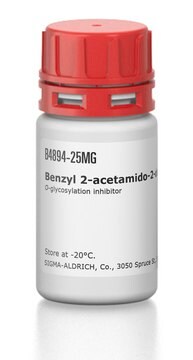おすすめの製品
品質水準
アッセイ
≥95% (HPLC)
フォーム
powder
色
white to beige
溶解性
DMSO: 5 mg/mL, clear (warmed)
保管温度
2-8°C
SMILES記法
[S](=O)(=O)(N(C)C)c1cc(c(cc1)N3CCCC3)C(=O)Nc2[s]c(cn2)C
InChI Key
QPKGRLIYJGBKJL-UHFFFAOYSA-N
生物化学的/生理学的作用
NGI-1 (ML414) is an inhibitor of Asparagine (N)-linked glycoslysation.
NGI-1 (ML414) is an inhibitor of Asparagine (N)-linked glycoslysation. NGI-1 inhibits the oligosaccharyltransferase, preventing the attachment to the protein. NGI-1 has been shown to induce senescence in receptor tyrosine kinase dependent tumors.
保管分類コード
11 - Combustible Solids
WGK
WGK 3
最新バージョンのいずれかを選択してください:
Angelyn Larkin et al.
Biochemistry, 50(21), 4411-4426 (2011-04-22)
Asparagine-linked glycosylation involves the sequential assembly of an oligosaccharide onto a polyisoprenyl donor, followed by the en bloc transfer of the glycan to particular asparagine residues within acceptor proteins. These N-linked glycans play a critical role in a wide variety
Danielle Skropeta
Bioorganic & medicinal chemistry, 17(7), 2645-2653 (2009-03-17)
In a series of investigations, N-glycosylation has proven to be a key determinant of enzyme secretion, activity, binding affinity and substrate specificity, enabling a protein to fine-tune its activity. In the majority of cases elimination of all putative N-glycosylation sites
Cecilia Lopez-Sambrooks et al.
Nature chemical biology, 12(12), 1023-1030 (2016-10-25)
Asparagine (N)-linked glycosylation is a protein modification critical for glycoprotein folding, stability, and cellular localization. To identify small molecules that inhibit new targets in this biosynthetic pathway, we initiated a cell-based high-throughput screen and lead-compound-optimization campaign that delivered a cell-permeable
Ryan A Flynn et al.
Cell, 184(12), 3109-3124 (2021-05-19)
Glycans modify lipids and proteins to mediate inter- and intramolecular interactions across all domains of life. RNA is not thought to be a major target of glycosylation. Here, we challenge this view with evidence that mammals use RNA as a
ライフサイエンス、有機合成、材料科学、クロマトグラフィー、分析など、あらゆる分野の研究に経験のあるメンバーがおります。.
製品に関するお問い合わせはこちら(テクニカルサービス)







